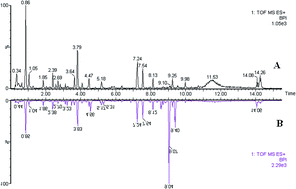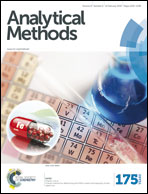Untargeted lipidomics study of coronary artery disease by FUPLC-Q-TOF-MS†
Abstract
Coronary heart disease (CHD) has emerged as a major public health problem worldwide. However, the complex biological networks of lipid metabolism of CHD patients are largely unknown. Lipidomics is a branch of metabolomics, which encompasses the global study of lipids and their biological functions. Current mass spectrometry methodologies allow the detection and quantification of multiple molecular lipid species with various structural and functional roles. Here, we developed an untargeted lipidomics approach based on fast ultra-performance liquid chromatography coupled with quadrupole time-of-flight mass spectrometry (FUPLC-Q-TOF-MS) to profile the lipid changes in CHD patients, to discover potential biomarkers to clarify lipid metabolism of CHD patients. Untargeted lipidome analysis coupled with multivariate data analysis clearly discriminated the CHD patients and normal persons. A total of four metabolites, PE(16:1(9Z)/0:0), aldosterone, 2-acyl-sn-glycero-3-phosphocholine, and alhpa-tocopheronic acid, were defined as “marker lipids,” which can be used to distinguish the CHD patients and normal subjects. Differentially expressed metabolites implied that glycerophospholipid metabolism, glycerolipid metabolism, and steroid hormone biosynthesis networks were acutely perturbed by CHD. These findings provide further insights into the lipid profile across a wide range of biochemical pathways of CHD.


 Please wait while we load your content...
Please wait while we load your content...